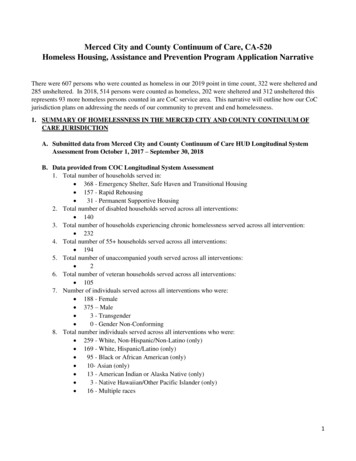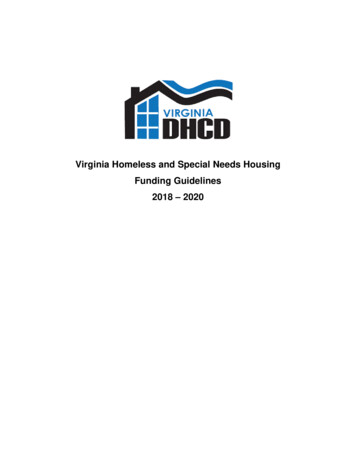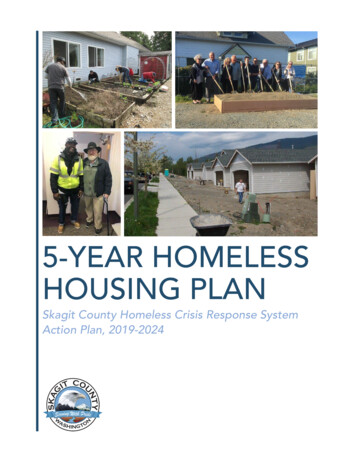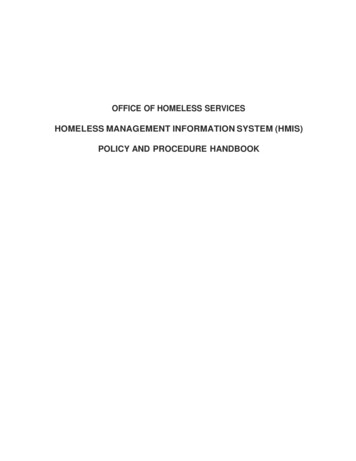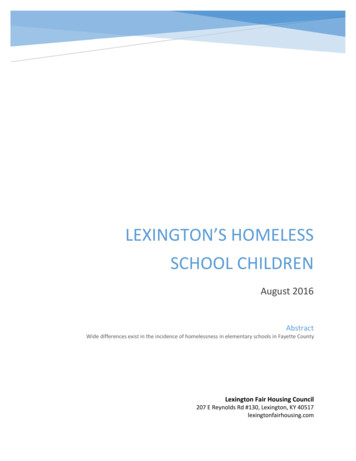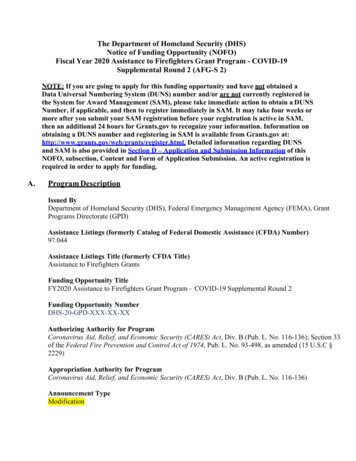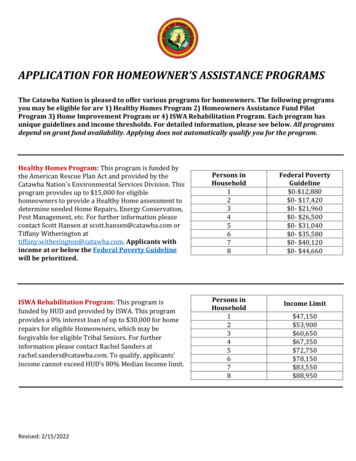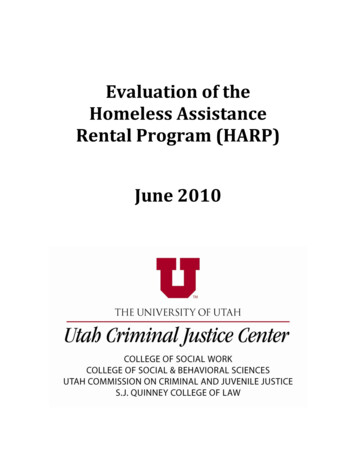
Transcription
Evaluation of theHomeless AssistanceRental Program (HARP)June 2010
Evaluation of the Homeless Assistance Rental Program (HARP)Final ReportAudrey O. Hickert, M.A.Erin E. Becker, M.C.J.Moisés Próspero, Ph.D.June 2010Utah Criminal Justice Center, University of Utah
{THIS PAGE INTENTIONALLY LEFT BLANK}
Table of ContentsTable of Contents . iAcknowledgements . iiExecutive Summary .iiiBackground and Introduction . 1Literature Review . 2Methods . 8Participant Selection . 8Data Sources . 9Surveys . 10Analyses . 11Results . 12Client Characteristics . 12Supportive Housing Services . 13Outcomes. 22Housing Outcomes . 22Criminal Justice Changes. 25Substance Abuse/Treatment Changes . 31Mental Health/Treatment Changes . 33Public Assistance/Shelter Changes . 35Client Perspectives . 37Case Manager Perspectives. 45Factors Related to Success . 46Successful Housing Exit . 46Recidivism . 50Proposed HARP “Tracks” . 54Discussion and Conclusion . 57Bibliography. 63Appendices . 66Appendix A: Data by Sources. 66Appendix B: Self Sufficiency Matrix Results . 68i
AcknowledgementsWe wish to thank Michael Gallegos, Community Resources and Development Division Director, forproviding us with the opportunity to conduct this study. We would also like to thank KerrySteadman at CRDD for his ongoing support in helping us understand the nuances of HARP andconnecting us with valuable individuals at partnering agencies. Without the support and assistanceof Mr. Gallegos and Mr. Steadman this research could not have been completed. The followingpartnering agency heads also provided their support for this project: Gary Dalton, Criminal JusticeServices; Gregory Gardner, Department of Workforce Services; Kerry Bate, Housing Authority of theCounty of Salt Lake; Matthew Minkevitch, The Road Home; and Patrick Fleming, Substance AbuseServices. Catherine Carter, Research and Evaluation Manager at Valley Mental Health, also providedsupport.Our sincerest thanks go out to Julia Potter and Janice Kimball at the Housing Authority for their helpin identifying an appropriate comparison group and their willingness to answer our ongoingquestions. The AmeriCorp Volunteers at the Housing Authority, specifically John Leonard andBrenda Sieczkowski, also provided valuable information and answered our many queries.We also owe a debt of gratitude to the many agencies and dedicated individuals who provided uswith quality data for this report. These partners went “above and beyond” in carefully finding ourstudy sample in their data records. We specifically thank: Floyd Hair, Housing Authority; JustinHyatt, Valley Mental Health; Cory Westergard, Substance Abuse Services; Dave Nicoll, CriminalJustice Services; Rick Little, Department of Workforce Services; Michelle Eining and David Musick,The Road Home; Keith Thomas, Salt Lake County Sheriff’s Office; Laurie Gustin, Bureau of CriminalIdentification; and Julie Christenson, Utah Department of Corrections.Our appreciation is also extended to the HARP case managers who assisted us with surveying theHARP clients and participated in their own survey of HARP issues. Michelle Flynn and MelanieZamora at The Road Home also assisted in survey distribution for the TBRA comparison group.Their contributions are greatly appreciated. We thank HARP and TBRA participants whoparticipated in our survey and provided valuable feedback on their experiences with housing andsubsequent successes and challenges.Lastly, we acknowledge our own University of Utah colleagues for their contributions to this study.We wish to thank Mary Beth Vogel-Ferguson for her thoughtful input on surveying and datacollection. We also acknowledge the following Utah Criminal Justice Center research assistants:Crystal Lim for distributing client surveys and hand entering data from several sources andBrittany Pierce for conducting the literature review.ii
Executive SummaryIn 2009 the Salt Lake County Community Resources and Development Division (CRDD) asked the UtahCriminal Justice Center (UCJC) to conduct a follow-up study to their 2007 evaluation of the HomelessAssistance Rental Program (HARP). Specifically, CRDD was interested in finding out whether or not theassumptions from the first HARP study remained true and if HARP continued to fulfill its goals. Thefollowing research questions were the foundation of the study and were answered based on availableprogram records and a thorough search of the literature on homelessness interventions. The current studyexamines all HARP clients from inception through August 1, 2009 (N 222) and compares them to a groupof homeless individuals who received a similar type of supportive housing intervention (Tenant BasedRental Assistance (TBRA) through The Road Home Shelter, N 231).1. Did assumptions from the first HARP study hold true?Yes, HARP clients continued to show a dramatic decline in involvement in the criminal justice systemfollowing HARP participation. The inclusion of a comparison sample in this study (TBRA) showed thatalthough HARP clients were significantly more involved in the criminal justice system prior to housing (e.g.,43% vs. 21% bookings in jail in the year prior to housing; 19% vs. 8% w/ new charge booking), afterhousing participation, jail bookings, new charge bookings, and statewide arrest rates declined sodramatically for HARP that they were not significantly different than TBRA client rates (HARP 13% newcharge bookings 1 year post-exit vs. 19% TBRA; HARP 31% new statewide arrest 1 year post-exit vs. 21%TBRA).HARP clients also showed a trend of reduced involvement with the county’s criminal justice services (CJS),substance abuse (SAS), and mental health (VMH) divisions following HARP participation. In some cases thisdecline also reached statistical significance (e.g., one year jail bookings and mental health treatmentservices pre/post housing). This may suggest a reduced need for these services, as the decline coincidedwith housing participation and growing stability in the clients’ lives. TBRA participants, on the other hand,showed a relatively steady use of these services across all time periods. Among HARP clients who remain inmental health (MH) treatment during and post-housing, the percent that successfully complete a treatmentepisode increases. However, among HARP clients who remain in substance abuse (SA) treatment duringand post-housing, the percent that successfully complete a treatment episode decreases. This may suggestthat those who remain in SA treatment have more severe addictions that are more difficult to treat.2. Has HARP continued to fulfill its intent/goals?HARP has continued to fulfill its intended goals, with 90% of those found in jail records (75% of HARPsample overall) having a jail booking in the three years prior to housing. HARP has also continued to divertclients from residential treatment into supportive housing, with 51% of those who received MH treatmentin the two years prior to housing utilizing residential services. The percent of clients in MH treatmentduring HARP who received residential services dropped to 27%. Of those receiving SA treatment duringeach time period, those who had residential SA treatment admissions dropped from 72% in the two yearsprior to HARP to 15% during HARP.HARP has also continued to provide the services that define the supportive housing model. For example,HARP case managers (CM) met with HARP clients every 13 days, on average, with 75% of HARP clientsmeeting with their CM every 18 days or more frequently. CM visits were more frequent in the first threemonths of HARP than in months 4-12; however, for those who remained in housing over 12 months, thefrequency of CM contacts increased again. This may suggest that those clients who remain in housing forlonger periods of time require additional support and services. A separate analysis of CM visits by howlong clients had been in HARP also supported this interpretation. Clients who were in HARP for over 24iii
months had CM contacts much more frequently throughout their participation (every 5 days on average)than those who exited more quickly. Changes in client functioning on the self-sufficiency (SS) matrices alsosupport this theory that clients who remain in the program for longer periods of time are those that requiremore resources and services.The average length of time in HARP (for exited clients) has increased from the last report (14 months vs. 9),while the average monthly rent plus utilities contribution by HARP has increased slightly ( 487 vs. 454).Client rent contributions have remained steady at about 25% of total cost. In spite of a higher per clientaverage cost ( 6,672: HARP average monthly rent plus utilities contribution of 487 multiplied by 13.7months as the average length of HARP participation for former clients), HARP has a criminal justice costbenefit of 2.71 return on every dollar invested (compared to 2.64 in the last report), primarily due to alarge decrease in potential victim costs because of the large reduction in recidivism. Based on the currentreduction in recidivism, per-participant victim benefits are approximately 11,800 (from estimatedreductions in future expenses and loss of assets). Although HARP operates at a cost to taxpayers, it iseffective in reducing future victimization and associated costs. It is also important to remember that thecost-benefit model used in this study only includes criminal justice costs, such as those produced from lawenforcement, prosecution, courts, and incarceration (jails and prisons). Other potential costs/benefits totaxpayers from human services and other areas are not included in the Utah Criminal Justice Cost-BenefitModel; therefore, the present analysis is a conservative estimate of the cost-benefits of HARP.The successful completion rate for HARP clients has also remained relatively stable since the firstevaluation, with 38% leaving on a positive exit status during the first report compared to 31% exitingsuccessfully in this report (the following table compares some selected results from the 2007 HARP studywith the current study’s findings).Comparison HARP 2007 Study to Current Study10211/7/2007Current HARP Study(2010)2229/1/20096318127661771199 41771413 667232 2.6436 2.713819433126432007 HARP StudyNumber of ClientsClients from inception throughReferral SourcesSubstance Abuse (%)Mental Health (%)Criminal Justice (%)Youth Services (%)Participation DetailsMonths in Housing (Mn) (for exited clients)Days between case manager contacts (Md)Per participant cost (Mn)OutcomesRecidivism Event 1 (%)Criminal Justice Cost-Benefit2Exit StatusPositive (%)Neutral (%)Negative (%)1Recidivism in 2007 report defined as a new BCI arrest or JEMS new charge booking following housing start.2010 measure also included new prison commitments, which only accounted for 4 of the 79 recidivists.2Return on every 1 invested in the programiv
At a year following housing start, approximately 50% of both TBRA and HARP clients remained stablyhoused in their respective programs. One-year stably housed rates in the literature range from 37% for asample of homeless mentally ill receiving intensive case management (ACCESS; Mares & Rosenheck, 2004)to 62-74% of clients in community residences (Siegel et al., 2006) to over 80% of clients in supportivehousing (Kasprow et al., 2000; Wong et al., 2008; Siegel et al., 2006). The HARP and TBRA stably housedrates fall within this range. In addition, a combined 12 month stably housed rate was calculated for HARP,including those who left the program positively within the first year (self-sufficient, long-term housing suchas Section 8). This stable housing rate was 77%. Factors associated with successful exit from HARP werehaving a new child during HARP housing (only 6 clients, but 83% successfully exited) and less priorinvolvement with the criminal justice system. High risk/need clients (e.g., have children, female, younger, inMH treatment) have successfully exited HARP; however, they generally require a longer time in housingprior to successful exit.3. Do self-sufficiency matrices and housing first matrices show improvements in clientfunctioning?Clients’ ratings seemed to rise across the first year of participation, and then began to drop after that forthose who remained in housing and had matrices completed after their first year. This drop was especiallynotable for life skills, income, and mental health. This trend could be isolating the higher need clients whoremain in housing longer than a year.4. What type of client does best in HARP?Those with less prior involvement with the criminal justice system are more likely to successfully exitHARP and have no new criminal events. However, even among those who had a new charge booking in thethree years prior to HARP, 56% have not yet had a new offense since starting housing. The overall trendsfor HARP clients show a high percent with involvement in the criminal justice system, CJS services, and SAand MH treatment prior to housing, but involvement with all systems decreased during and post-housing.These trends emphasize the impact a program can have when serving high risk clientele. Although high riskclients are more likely to have negative outcomes (negative exit/recidivism), because of their high use ofintensive and costly services prior to housing, a more dramatic decline in system involvement can beobserved.a. Could those clients do as well in less intensive services?Based on the mix of clients that HARP currently serves, it is not advised for the program to offer lessintensive services (see “b” below).b. Does HARP need to serve a mix of client risk/need levels in order to maintain theturnover rate?Currently HARP serves a mix of clients that are disproportionately high risk. HARP leadership is exploringthe idea of implementing a risk/needs assessment and dividing potential HARP clients into different“tracks.” Based on the working information for HARP tracks, the evaluators used existing data on the HARPsample in this report to divide them into their appropriate groups. This resulted in four distinct HARPtracks:High-2: cases not flagged in three less-severe categories; defined by having higher range of pastsubstance abuse treatment admissions and/or jail bookings (n 36)High-1: SPMI (serious and persistent mental illness in VMH or CJS record pre/dur-housing) (n 116)Medium: not flagged as “High-1,” had prior successful substance abuse treatment discharge (prehousing) and in substance abuse treatment at housing start/during housing (n 35)Low: not flagged as “High-1” or “Medium,” had one or no jail bookings in the three years prior tohousing (n 35)v
As shown in the previous bullets, only 70 of the 222 HARP clients in this report (32%) are either mediumor low risk. The Low risk group has the best outcomes (highest percent with positive exit status (43%),longest average time in housing (over 17 months), and fewest with recidivism (14%)). Outcomes are fairlysimilar for the Medium and High-1 groups, despite the Medium group being defined more as a substanceabuse population and High-1 being defined as a mental health population. Just over one-quarter of eachgroup successfully exited housing, while around one-third of each group recidivated. The group that reallystood out from the others was the High-2 group which had recidivism rates almost double the next closestgroup (61%).5. Is there an assessment for identifying appropriate clients for a program like HARP or a moreshort-term (2-3 months) housing program?The literature review did not uncover any useful risk/need tools for HARP to identify clients who wereappropriate for their supportive housing program vis-à-vis a more short-term (2-3 month) housingintervention. In general the literature shows that the type of housing assistance needs to be matchedclosely to the needs of the clients, with higher need clients requiring more intensive (and usually costly)services. As shown above, HARP serves a primarily high risk clientele and, therefore, needs to provideintegrated support services. Although a ready-made assessment was not identified, the use of existing datafrom HARP partnering agencies shows that enough information is available to sort HARP clients into“tracks” that have distinctive profiles and success rates (see “b” above). It is recommended that HARPcontinue to explore the use of existing data on HARP-referred clients to use as a possible risk/needassessment.6. What is the cost-benefit of HARP vs. “bricks & mortar” programs like Sunrise or Grace MaryManor? Or other comparison programs (Project RIO, TBRA)?There was not enough information locally to compare HARP cost-benefit to “bricks & mortar” style housing.In addition, a search of the literature on cost-benefit of housing interventions primarily revealed howdifficult such a process is. For example, Jones and Pawson (2009) note that the simple principle of costeffectiveness is difficult to apply, requiring the measurement of the “counterfactual” (what would haveoccurred for all of those affected if the policies/services had not been in place), as well as a detailedassessment of fixed and variable cost structures (that are not always readily available). The limitedcriminal justice cost-benefit model does show that HARP operates with an approximate 2.71 return onevery dollar invested. Some of the literature also shows some non-monetary benefits of scattered-siteindependent supportive housing (such as HARP) vs. single-site “bricks & mortar” housing. For example,residents in independent housing (vs. concrete settings) reported greater independence (attending topersonal and household responsibilities such as cooking, cleaning, errands) and greater occupationalfunctioning, as well as feeling a greater sense of choice (Yanos, Felton, Tsemberis, & Frye, 2007).7. Does the model function as well as it could/should?a. Are varying agency goals/restrictions barriers to HARP’s goals? Would it be better tohave a single organization providing CM/support services? Is CM geared more towardhuman service (e.g., SA or MH tx completion) and housing (make sure they aremeeting HARP requirements) needs, but not enough assistance on self-sufficiency(i.e., employment, other forms of assistance to help get off of HARP)?Several questions were asked regarding HARP functioning and partnerships, especially concerning casemanagement and clients’ access to wrap-around support services. The literature provides some insight intothese topics, with the general recommendation that “team” approaches to service provision (such as ACTteams, with health, mental health, and case management professionals all working on a single team) andintegrated service provision (e.g., multiple services provided at a single site) are preferable. However,several approaches to housing and support services have been shown to be effective in the literature.vi
Based on client feedback (both current and former HARP clients), it appears that clients feel that their casemanagement and support service needs are being met with the current HARP model. Fifty-five (55) of 81(68%) HARP current clients completed surveys. Regarding case management, most HARP current clientsanswered that their case managers helped them with developing/understanding a case plan, made homevisits, and are responsive to requests. The areas that HARP current clients were most satisfied with theircase managers were: treating the client with respect (Mn 5.0 out of 5 point scale) and cultural sensitivity(Mn 4.8), as well as responsiveness to requests, making home visits, and helping develop/understandcase plan (all Mn 4.8). Overall satisfaction among current HARP clients could not be higher, withrespondents giving the program an average rating of 4.9 out of 5. Among former HARP clients, casemanagement was most often cited as the most helpful part of the housing program. Very few HARP currentor former clients provided suggestions on improving the program, with most stating that all of their needshave been met. Of those who provided suggestions, the most common included: jobs/employmentassistance, transportation, health/dental insurance for adults, and education/training opportunities(usually to help with employment). Some other barriers (see #8) and percent of clients using variousservices (see “b” below) suggest additional areas for improvement.Eight (8) HARP case managers participated in an online survey and described their role in the program.The group who responded to this survey was active in helping clients in several areas of their lives. Alleight reported helping with health care, education, and transportation, while six reported helping clientsobtain household items and employment. Half of the respondents also said that they help clients find childcare. When asked “What were the most important things you do to help your HARP client(s)?” casemanagers responded as often with items related to housing success/self-sufficiency (e.g., apply for HEATprogram, help with ADL’s) as they did with items related to treatment success (keep involved withtreatment/relapse prevention, keep on meds).b. Are DWS resources/referrals being used appropriately to get clients the help theyneed to become employed?Results from the current client surveys suggest that DWS resources are not being used appropriately orsufficiently to address employment challenges of HARP clients. In addition to help with jobs/employmentassistance being the #1 issue listed by clients for how to improve the program, only 69% of current clientsurvey respondents said they had used DWS employment assistance and among those the average ratingfor satisfaction was 3.9 out of 5 (among the lowest rated services). However, it should also be noted thateducation/employment accomplishments were the most frequently mentioned accomplishment by currentHARP clients as well.8. How do former and current clients view their experiences with HARP? What helped themsucceed? What barriers still exist?Current and former HARP clients view their experiences with HARP as overwhelmingly positive (giving theprogram an average rating of 4.9 out of 5). Current clients specifically mention housing assistance and thepositive impact it had on their lives (e.g., independence, safety, stability), followed by their case manager asthe most helpful parts of the program. Former HARP clients were most likely to mention the casemanagement (several mentioned their former case manager by name), followed by housing as the mosthelpful part of the program. The following client comments illustrate this point of view and how positivelythe supportive housing model (independent housing with vouchers for rent/utilities plus casemanagement) is viewed by the clientele:HARP Current:“Helping with a stable living environment while I continue to work on my recovery, mental healthissues and education. I hope to become self-sufficient within a year, maybe two.”“Helping me with housing and with paying part of the rent so me and my kids have a home.”vii
“Care, concern and support of case manager. Suggestions and referrals of case manager.”HARP Former:“Having a home for myself and my children. Remaining stable to provide for myself and my kids.”“Home visits I loved them. Wish there would have been more one on one visits”“The overall program. I had a place to live; I had a case manager whom I could tell everything to. I missthis being on Section 8.”Despite self-reported improvements in employment/education, substance use, and mental health issues,HARP current clients continue to encounter challenges to self-sufficiency and long-term stability.Employment was the most frequently mentioned challenge since entering HARP, followed byhealth/mental health issues. For former HARP clients, the two biggest challenges since leaving housingwere employment and no longer having case management. There was a 42% reduction in employmentfrom during housing to post-housing for this group. The primary barriers to employment post-housingwere depression/overwhelmed/MH issues (58%), followed by the need for more education (33%), and thedifficulty of finding a job with a criminal record (33%). More clients reported employment barriers for thepost-housing period than during housing.Overall Findings and RecommendationsThe results of this study reveal that the HARP program was cost-beneficial and successfully reducedrecidivism rates. Participants also showed reduced CJS involvement, substance abuse treatment, andmental health treatment. Additionally, using the HARP data, this study potentially identified groups thatcan be targeted for proper treatment matching (HARP “Tracks”). Because HARP targets primarily high riskclients, the program has shown more dramatic improvements in several areas than TBRA (that targets aless high-risk clientele).HARP should consider more intense client services in employment assistance, mental health, education,and transportation. This is based on HARP clients’ reports on barriers to finding and keepingemployment, which is vital to long term stability and self-sufficiency.HARP should also explore the use of an actuarial criminogenic risk/needs assessment and partner withan agency that can provide cognitive behavioral treatment to address these needs. This is based on thefact that one of the major factors related to recidivism and negative program exit was the criminal historyof the offender.The HARP program should also pursue the use of the HARP “tracks” to identify higher-risk clients at thetime of admission and match services accordingly. In addition, an overall trend that emerged acrossvarious data sources was that clients who remain in HARP housing for longer periods of time arethose that have the most difficulty managing self-sufficiency. In addition to the use of tracks to identifyand provide higher-level care to certain HARP participants, those who have already remained inhousing for over 18 months should be targeted for increased services and case plan for long-termsuccess.Lastly, for those clients who have substance abuse issues, it is recommended that evidence ofsuccessful treatment completion be shown prior to housing in HARP. For example, those whocompleted SA treatment recidivated at 26% compared to 43% for those who had past treatment but nosuccessful completions. It is not recommended that clients have entirely completed SA treatment, simplythat they have shown some success in a treatment admission prior to housing in HARP.viii
Background and In
dramatically for HARP that they were not significantly different than TBRA client rates (HARP 13% new charge bookings 1 year post-exit vs. 19% TBRA; HARP 31% new statewide arrest 1 year post-exit vs. 21% TBRA). HARP clients also showed a trend of reduced involvement with the county's criminal justice services (CJS),


